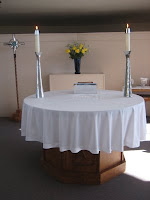
As I sat outside late yesterday, I was struck by the sounds. Joan’s mare, Lucy, pushed her hay trough around the pen, just on the other side of my garden. It makes a hollow banging sound. She does this often out of boredom. From inside my barn home, some 50 yards away, I sometimes hear the same racket that travels through the mostly open space separating her pen from the barn. The wind has been constant for most of the time I’ve been back here—gusting at 15-20 mph. Chimes from my garden are joined by chimes that hang from the beams of the carport behind Mother’s house. Mother’s house…when will I stop saying that? Mother’s house is now Joan’s house. I’m traveling. Somewhere else I’ve had this same sense of call to prayer. The feathered cohabitors of this garden busy themselves, as the sun drops, drops in the west, through Post Oaks still bare, the orange disk gone while the sky remains light and tinged with color. Overhead, a passenger jet, heading west from Houston 100-plus miles to the southeast, pierces the sky, too high for me to hear the sound. I suppose that Casey, the blue heeler, can hear it.
I thought I would be lonely here this time, after living in close quarters with ready companions for the last four months, and especially with the absence of friends nearby in this rural county who have chosen life nearer to the big city. Eight years ago I was ripe to leave a job, abandon the city. I thought I needed to escape—something—to solitude. How could I know that the world, my world was on the brink—that peace of mind was about to undergo a measurable redefining? On the eve of Mother’s 84th birthday, we took her to the emergency room 90 miles to the south. She was admitted to the Hospital. Four days later, Tuesday, September 11, 2001, my neighbor Nancy called. Turn on your television. A plane has crashed into the World Trade Center. The only guarantee is change. The solitude I so craved is still on my plate. Be wary of answered prayers.
Pay homage to the cellular age. Last night my friend Judy assured me from 175 miles away that I’m accomplishing as much as I should expect of myself—whatever that means and by whoever might be expecting something. Oh, that would be me, of course. “You’ve only been back a couple of days,” she insisted. Well, it had really been a week. As I looked homeward to Texas from Santa Fe over a month ago, dreading the work that lay ahead of me, friend Suzy cautioned me, “Don’t manifest that.” You will be fine. And though the dread became palpable when I smelled the feedlots of Clovis heading east to the Texas Panhandle, I knew I was okay. This morning I will move and stack the old bricks—TEXAS…MEXIA—that I retrieved from the rubble of the demolished tile shower sub floor. Late yesterday I found them partially buried in the debris on the contractor’s trailer. I’ve put out the first batch of mulch in the garden. Fourteen bags equal one yard. One yard fits comfortably into the rear of my Toyota 4Runner. The garden requires at least 20 yards. No mountain high enough.
For today, maybe I’ll clear the top of the credenza in the middle of the kitchen. Its original purpose was as a food preparation space. Maybe I’ll unpack my clothes. I’ve spilled the contents of my vehicle into a space in the bunkhouse living room that was already past capacity—dominoes teetering on the brink. Maybe I’ll read about Louisiana in the 19th century—a novel set in the area called home by the late Clementine Hunter, revered Black folk artist who died 20 years ago at age 101. Maybe I’ll put out a trap for the mouse that darted through the deconstructed bathroom early this morning and out a gaping hole at the bottom of the wall that adjoins the barn hallway. No doubt, he and his friends are having a heyday while my house stands compromised.
Disarray reigns, along with dust from the demolition of the old tile shower. Visitors? How? Last night I cautioned friend Steve, who abhors clutter, who abhors any unnecessary stuff, that I’m hesitant for him to visit from New Mexico. Before Mother died two years ago—Mother of the odd combination of keeper of things long past purpose and dusted, arranged tabletops—we observed that our aunt no longer invites us over. She had reduced her house to paths, her kitchen counters to a patchwork of miniature workspaces. Horrors, I’m working off of the same paradigm. While visiting the other day, sister Sue assured me, “It’s not that bad.” A few days earlier, sister Joan observed over coffee one morning, “At least it’s organized.” Would it be easier to be here, mostly alone—solitary in the garden, upstairs looking out onto the deck and into the cow trap below and the hayfield farther east, in the downstairs bedroom at night, book in hand and occasionally glimpsing the moonlit sky through the door that leads to the outdoor bath—just me and the chimes, and the songbirds, and the Mouse?
East of Clovis—Normangee, Texas (February 28, 2009)
R. Harold Hollis








